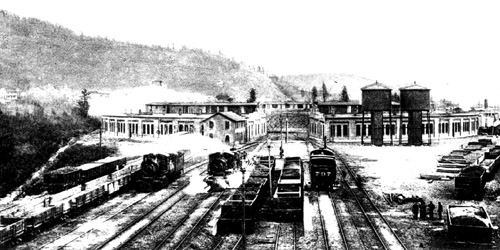
| |
This roundhouse was built in 1906 on a large piece of property which extended from Fonda Avenue to
Richard's Crossing, approximately 350 acres, "thereby bestowing upon Oneonta the distinction of hosting
the largest roundhouse in the world, a claim that went unchallenged for over a quarter of century."
(From The Oneonta Roundhouse by Jim Loudon) The roundhouse itself was over 400 feet in diameter with
a 75 foot turntable. There were 52 stalls and it said to be the largest roundhouse in the world.
The economic climate of Oneonta benefitted greatly from the usage of this facility. In 1924 a new turntable,
105 feet long, was installed to accommodate the longest locomotives. When the use of steam power gave way to
disesel power, the activity began to diminish. In 1954 the demolition of the structure started and 36
stalls were gone. The others were rented to companies for storage. In 1993 the rest of the roundhouse was
demolished.
|
Questions and Facts about Oneonta, New York
Q: What does Oneonta mean?
[ Return to top ]
A: From information provided by William A. Starna, Professor Emeritus of Anthropology, SUNY Oneonta,
Although Oneonta has long been known as the "City of the Hills," its name, derived from a Mohawk Indian word, does not have a similar meaning. Pronounced o-neny-onda, Oneonta can literally be translated as "rocks sticking out," a reference to the exposed bedrock cliff faces found on the east end and north side of the city.
Q: Has Oneonta ever been known by a different name?
[ Return to top ]
A: Also according to Professor Starna, Oneonta was first known as McDonald's Mills. Beginning in 1817, it became Milfordville.
It wasn't until 1830 that the township of Oneonta was formed.
According to at least one historian, the city's nickname used to be "Clipnocky," a word said to refer to the presence of "clip joints"
and the aggressiveness of frontier life. But “Clipnocky” is actually derived from a corruption of the Dutch word klipachtig,
meaning "craggy place" or "rocky place," which echoes the Mohawk language meaning of “Oneonta.” That Clipnocky had something to do with “clip joints” is a folk etymology, a meaning invented by local English speakers based on the sound of the original word as pronounced by early Dutch settlers of the region.
Q: What is the oldest standing structure in the city of Oneonta?
[ Return to top ]
A: The oldest standing structure is the Swart-Wilcox house in Oneonta's Sixth ward.
Q: When did Oneonta first get electric lights?
[ Return to top ]
A: In 1887 the Oneonta Electric Light & Power Company was organized.
A dynamo to furnish power for arc lighting was installed in the gas home.
In the early days, electricity was used only from duck to dawn.
Q: When did Oneonta become a city?
[ Return to top ]
A: Oneonta became a city on January 1, 1909. it had been incorporated as a village
in June of 1848. Originally, the town of Oneonta was formed in 1830 from the towns
of Milford, Otego, and Huntsville. However, the first settlers came as early as before
the Revoluntionary War.
Q: Who was the first settler?
[ Return to top ]
A: The Dutch passed down the Susquehanna River as early as 1614-15. The first settler
in the area now known as the town of Oneonta is considered to be Henry Scramling. He secured
a grant of 1,000 acres in the Susquehanna Valley and settled in the Oneonta Plains near the
mouth of the Otego Creek several years prior to the Revolutionary War. Joachim Vanderwerker
built the first log cabin within the present-day Oneonta city limits in 1775. Vanderwerker
left during the Revoluntionary War but returned to McDonald's Mills and constructed the
area's first grist mill. (From the Daily Star, January 1, 1909)
Q: When did the railroad come to town?
[ Return to top ]
A: The day the Albany and Susquehanna Railroad came to town, August 29, 1865,
is considered by some to be Oneonta's greatest day. That day, the first excursion train
from Albany to Oneonta arrived to the awe of the largest crowd the village had ever witnessed.
Q: What kept Oneonta's economy going when the railroad became a less viable business?
[ Return to top ]
A: Economics always relies on so many variables. However, the two colleges, SUCO and Hartwick
College can be claimed as the city's biggest economic boon. Indeed, without these institutions of
higher learning, Oneonta would not be what it is today. Currently, the population of Oneonta doubles
in size during the school year. An additional larger employer in Oneonta and the region is in
health care, specifically The Fox Care Network and Bassett Healthcare.
Q: When was the first fire company formed?
[ Return to top ]
A: History tells us that the first Fire Company in the village of Oneonta was organized in
May of 1847. The company existed until around 1858. The "bucket brigade" was in operation until 1876.
The Oneonta Fire Department was formed June 1, 1876.
Have a question about Oneonta's history?
The historian will do his best to answer it, or refer you on where to search:
info@oneontanyhistorian.com
© 2023 Website: www.oneontanyhistorian.com
Website Design and Hosting provided by L & J Consultants
|
![]()